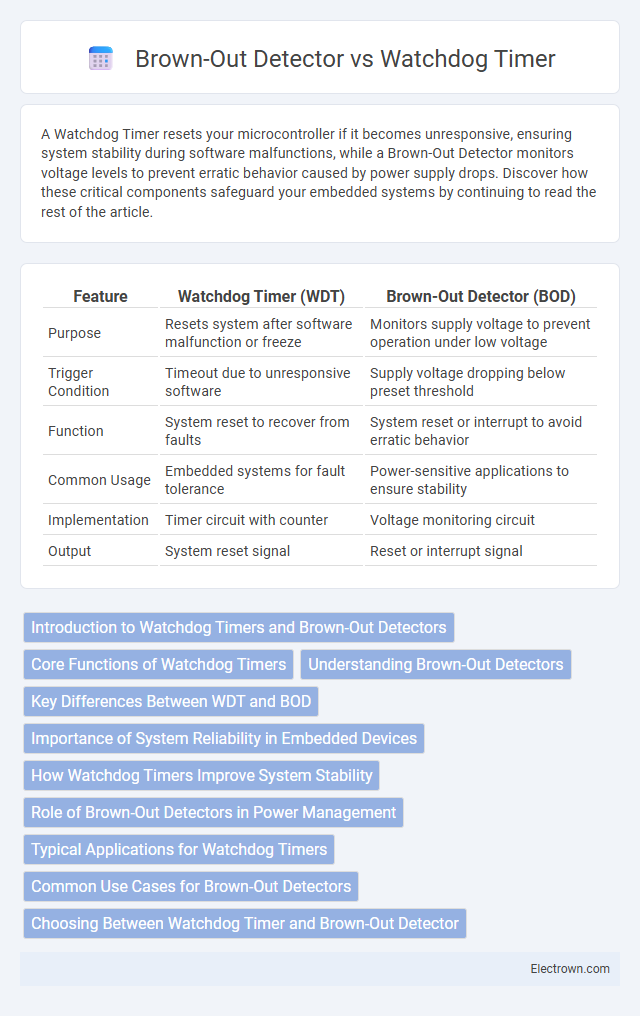A Watchdog Timer resets your microcontroller if it becomes unresponsive, ensuring system stability during software malfunctions, while a Brown-Out Detector monitors voltage levels to prevent erratic behavior caused by power supply drops. Discover how these critical components safeguard your embedded systems by continuing to read the rest of the article.
Table of Comparison
| Feature | Watchdog Timer (WDT) | Brown-Out Detector (BOD) |
|---|---|---|
| Purpose | Resets system after software malfunction or freeze | Monitors supply voltage to prevent operation under low voltage |
| Trigger Condition | Timeout due to unresponsive software | Supply voltage dropping below preset threshold |
| Function | System reset to recover from faults | System reset or interrupt to avoid erratic behavior |
| Common Usage | Embedded systems for fault tolerance | Power-sensitive applications to ensure stability |
| Implementation | Timer circuit with counter | Voltage monitoring circuit |
| Output | System reset signal | Reset or interrupt signal |
Introduction to Watchdog Timers and Brown-Out Detectors
Watchdog timers are integrated circuits or software modules designed to reset microcontrollers when the system becomes unresponsive, preventing system hangs and ensuring reliable operation. Brown-out detectors monitor the supply voltage and trigger a system reset or interrupt when voltage levels drop below a predefined threshold, protecting against unsafe operation during voltage sags. Both components play crucial roles in embedded systems by enhancing stability and preventing malfunction due to timing failures or power irregularities.
Core Functions of Watchdog Timers
Watchdog timers ensure system reliability by automatically resetting a microcontroller if the software fails or gets stuck in an infinite loop, preventing system crashes and data corruption. These timers monitor software execution by requiring regular resets within a set time frame, enabling detection of anomalies in real-time. Your embedded system's stability depends on the watchdog timer's core function of timely intervention to maintain continuous operation.
Understanding Brown-Out Detectors
Brown-Out Detectors (BODs) monitor the power supply voltage to prevent microcontroller malfunction during voltage drops by triggering a reset or interrupt when voltage falls below a preset threshold. Unlike Watchdog Timers that detect software malfunctions, BODs specifically safeguard against hardware power issues by ensuring stable voltage levels for reliable operation. Integrating BODs helps maintain system integrity by avoiding unpredictable behavior caused by insufficient voltage during brown-out conditions.
Key Differences Between WDT and BOD
Watchdog Timer (WDT) monitors system operation by resetting the microcontroller if the software fails or hangs, ensuring reliable execution and preventing system lockups. Brown-Out Detector (BOD) detects low voltage conditions and triggers a reset or interrupt to avoid erratic behavior due to insufficient supply voltage. Key differences include WDT focusing on software failure detection while BOD focuses on voltage supply monitoring, with WDT actively controlling system uptime and BOD safeguarding against power instability.
Importance of System Reliability in Embedded Devices
Watchdog Timers and Brown-Out Detectors are crucial for maintaining system reliability in embedded devices by preventing system crashes and ensuring proper operation during power fluctuations. A Watchdog Timer resets the system in case of software malfunctions, while a Brown-Out Detector monitors voltage levels to avoid erratic behavior during low power conditions. Ensuring your embedded system includes both components significantly enhances uptime and operational stability.
How Watchdog Timers Improve System Stability
Watchdog Timers enhance system stability by continuously monitoring the operation of microcontrollers and triggering a system reset if a software fault or hang is detected, preventing prolonged malfunction. Unlike Brown-Out Detectors that primarily protect against voltage drops by resetting the system during power failures, Watchdog Timers address software reliability and responsiveness. Incorporating a Watchdog Timer ensures Your embedded system maintains consistent performance and recovers automatically from unexpected errors.
Role of Brown-Out Detectors in Power Management
Brown-Out Detectors play a crucial role in power management by monitoring the supply voltage and ensuring it remains above a specified threshold to prevent unpredictable behavior in microcontrollers. Unlike Watchdog Timers, which reset the system during operational faults or software malfunctions, Brown-Out Detectors trigger resets during power dips, protecting the system during brown-out conditions. Effective use of Brown-Out Detectors enhances system reliability and prevents data corruption caused by insufficient voltage levels.
Typical Applications for Watchdog Timers
Watchdog timers are typically used in embedded systems to ensure reliable operation by resetting the microcontroller if it becomes unresponsive due to software errors or hardware faults. Common applications include automotive control systems, industrial automation, and consumer electronics where system stability and fault recovery are critical. Your system benefits from watchdog timers by maintaining continuous operation and preventing lockups during unexpected conditions.
Common Use Cases for Brown-Out Detectors
Brown-out detectors are commonly used in microcontroller systems to prevent unpredictable behavior by monitoring voltage supply levels and triggering a reset when the voltage drops below a specified threshold. This ensures system stability during power fluctuations, especially in battery-operated devices, embedded systems, and safety-critical applications such as automotive electronics and medical devices. Unlike watchdog timers that primarily detect software malfunctions, brown-out detectors safeguard hardware reliability by maintaining proper voltage conditions.
Choosing Between Watchdog Timer and Brown-Out Detector
Choosing between a Watchdog Timer and a Brown-Out Detector depends on your system's specific needs for reliability and fault tolerance. A Watchdog Timer monitors software execution and resets the system if the program becomes unresponsive, ensuring your device recovers from software malfunctions. In contrast, a Brown-Out Detector safeguards your hardware by detecting low voltage conditions and initiating a reset to prevent erratic system behavior caused by insufficient power.
Watchdog Timer vs Brown-Out Detector Infographic

 electrown.com
electrown.com